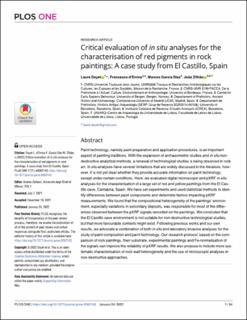| dc.contributor.author | Dayet, Laure | |
| dc.contributor.author | d'Errico, Francesco | |
| dc.contributor.author | Garcia Diez, Marcos | |
| dc.contributor.author | Zilhão, João | |
| dc.date.accessioned | 2023-03-01T14:19:46Z | |
| dc.date.available | 2023-03-01T14:19:46Z | |
| dc.date.created | 2022-01-05T18:39:46Z | |
| dc.date.issued | 2022 | |
| dc.identifier.issn | 1932-6203 | |
| dc.identifier.uri | https://hdl.handle.net/11250/3055070 | |
| dc.description.abstract | Paint technology, namely paint preparation and application procedures, is an important aspect of painting traditions. With the expansion of archaeometric studies and in situ non-destructive analytical methods, a renewal of technological studies is being observed in rock art. In situ analyses have several limitations that are widely discussed in the literature, however. It is not yet clear whether they provide accurate information on paint technology, except under certain conditions. Here, we evaluated digital microscopic and pXRF in situ analyses for the characterisation of a large set of red and yellow paintings from the El Castillo cave, Cantabria, Spain. We have set experiments and used statistical methods to identify differences between paint components and determine factors impacting pXRF measurements. We found that the compositional heterogeneity of the paintings’ environment, especially variations in secondary deposits, was responsible for most of the differences observed between the pXRF signals recorded on the paintings. We concluded that the El Castillo cave environment is not suitable for non-destructive technological studies, but that more favourable contexts might exist. Following previous works and our own results, we advocate a combination of both in situ and laboratory invasive analyses for the study of paint composition and paint technology. Our research protocol, based on the comparison of rock paintings, their substrate, experimental paintings and Fe-normalisation of the signals can improve the reliability of pXRF results. We also propose to include more systematic characterisation of rock wall heterogeneity and the use of microscopic analyses in non-destructive approaches. | en_US |
| dc.language.iso | eng | en_US |
| dc.publisher | PLOS | en_US |
| dc.rights | Navngivelse 4.0 Internasjonal | * |
| dc.rights.uri | http://creativecommons.org/licenses/by/4.0/deed.no | * |
| dc.title | Critical evaluation of in situ analyses for the characterisation of red pigments in rock paintings: A case study from El Castillo, Spain | en_US |
| dc.type | Journal article | en_US |
| dc.type | Peer reviewed | en_US |
| dc.description.version | publishedVersion | en_US |
| dc.rights.holder | Copyright 2022 The Author(s) | en_US |
| dc.source.articlenumber | e0262143 | en_US |
| cristin.ispublished | true | |
| cristin.fulltext | original | |
| cristin.qualitycode | 1 | |
| dc.identifier.doi | 10.1371/journal.pone.0262143 | |
| dc.identifier.cristin | 1975460 | |
| dc.source.journal | PLOS ONE | en_US |
| dc.relation.project | Norges forskningsråd: 262618 | en_US |
| dc.identifier.citation | PLOS ONE. 2022, 17 (1), e0262143. | en_US |
| dc.source.volume | 17 | en_US |
| dc.source.issue | 1 | en_US |

